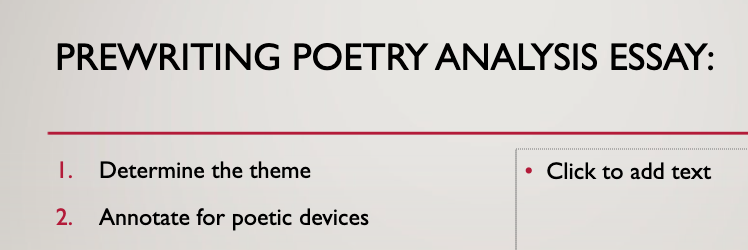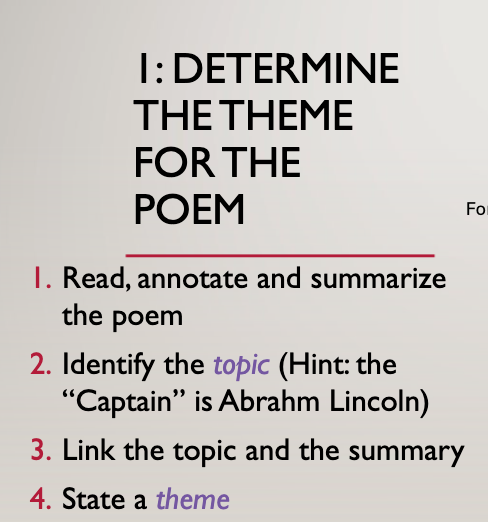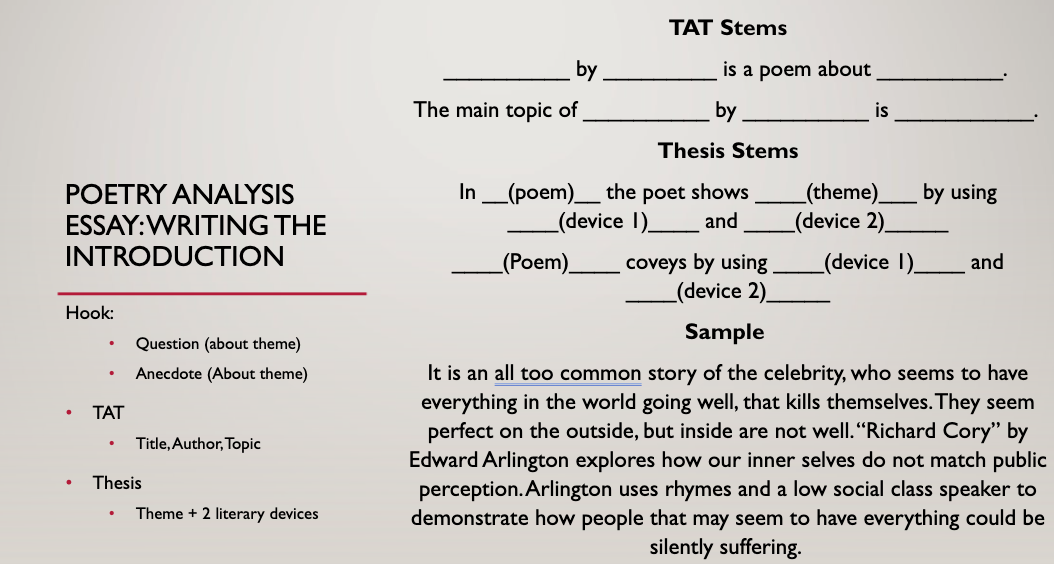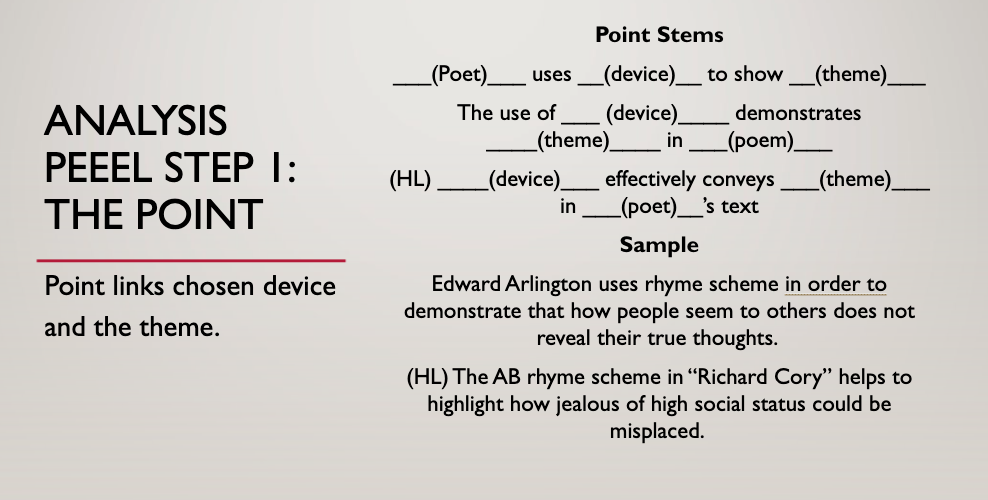
First what is the topic? (one word, the BIG IDEA)
It is the subject or focus of the poem.
example: teamwork, death, homework, love
Then, what is the theme? (Using the topic, create a sentence that describes the theme).
A theme is a sentence that gives a claim about a topic.
Examples:
topic: teamwork
theme: Teamwork is only effective if everyone contributes.
topic: homework
theme: Homework is annoying but necessary.
topic: death
theme: Death is not something we should fear.

How do we unlock a theme in a poem or text.
1) annotate + summarize
2) identify the topic
3) How does our annotation/summary link to the topic?
4) State the theme.
The Little Seedling
Poem:
A little seed in the ground,
Waits for rain to come around.
Sunlight whispers, “Grow, be free,”
Now a tree for all to see.
1. Annotation:
Line 1: “A little seed in the ground” → Introduces the subject (a seed) and its setting (the ground).
Line 2: “Waits for rain to come around” → Suggests patience and dependence on nature.
Line 3: “Sunlight whispers, ‘Grow, be free'” → Personifies sunlight, encouraging growth and freedom.
Line 4: “Now a tree for all to see” → Shows the seed’s transformation into a tree, symbolizing achievement and visibility.
Summary:
The poem describes the journey of a seed that patiently waits for rain and sunlight to grow into a tree. It highlights the natural process of growth and transformation, emphasizing the seed’s potential and eventual success.’
2. Identify the Topic
topic: growth and transformation.
3. How does our annotation link to the topic?
Our annotation shows personification (sunlight whispers)
and imagery “little seed”, “in the ground”, “rain”.
Summary –
The the poem uses personification and natural imagery to convey the idea of growth and potential.
4. Theme
With time, care, and the right conditions, even the smallest beginnings can transform into significant success.
The Ocean’s Heart
The Ocean’s Heart (with annotation)
Metaphor: “The ocean is a restless beast” (compares the ocean to a wild animal).
Simile: “Its waves like claws that never cease” (compares waves to claws using “like”).
Personification: “It roars with anger, hums with grace, ” (ocean roars and hums)
Metaphor: “A mirror of time” (compares the ocean to a mirror reflecting time).
Beneath the surface, secrets hide,
Simile: “Like treasures locked deep inside” (compares secrets to treasures using “like”).
Metaphor: “Its heart, a mystery” (compares the ocean’s depths to a heart).
A world of wonder, where dreams reside.
1) Summarize
Summary:
The poem describes the ocean as a powerful, unpredictable force, comparing it to a restless beast and a mirror of time. It highlights the ocean’s dual nature—its surface is wild and untamed, while its depths hold hidden secrets and beauty. The ocean is portrayed as both mysterious and awe-inspiring, a place where dreams and wonders coexist.
2) Identify a Clear Understandable Topic
topic: nature’s duality
3) How Does Our Annotation and Summary Link to the Topic?
The poem uses metaphors and similes that describe the ocean’s characteristics, such as its restless surface (“restless beast,” “waves like claws”) and its mysterious depths (“treasures locked deep inside,” “heart, a mystery”).
The summary ties these elements together, showing how the ocean’s surface and depths reflect its dual nature. This directly links to the topic by explaining how the poetic devices illustrate the ocean’s power and mystery.
4) State the Theme
theme:
Nature wild and powerful, yet in its depths, there lurks full of mystery and hidden beauty.
The Gigantic Storm
“The Gigantic Storm”
The wind whipped wildly, whirling waves so wide,
The sky screamed silver, lightning lit the tide.
The rain roared louder than a lion’s fierce cry,
A storm so strong it scraped the stars from the sky.
1) Annotate and Summarize
Annotation:
Alliteration: “wind whipped wildly,” “sky screamed silver,” “lightning lit the tide,” “rain roared louder,” “storm so strong,” “scraped the stars.”
Hyperbole: “it scraped the stars from the sky” (exaggeration to emphasize the storm’s power).
Imagery: Vivid descriptions of wind, sky, lightning, rain, and stars.
Summary:
The poem describes an intense storm using exaggerated language and repeated sounds. The wind, sky, lightning, and rain are portrayed as overwhelmingly powerful, with the storm even affecting the stars.
2) Identify a Clear Topic
Topic: Nature’s power
Nature’s power –> such as the hyperbole (exaggerating the storm’s strength)
Nature’s power –> alliteration (emphasizing the storm’s intensity through sound).
Nature’s power –> The vivid imagery of wind, lightning, and rain further reinforces the idea of nature’s dominance.
3) How Annotation and Summary Link to the Topic
The annotation highlights the use of hyperbole and alliteration, which both emphasize the storm’s immense power.
The summary ties these poetic devices to the central idea of nature’s overwhelming force, showing how the storm is portrayed as larger-than-life and uncontrollable.
4) State the Theme
Theme: The uncontrollable power of nature dominates life.





